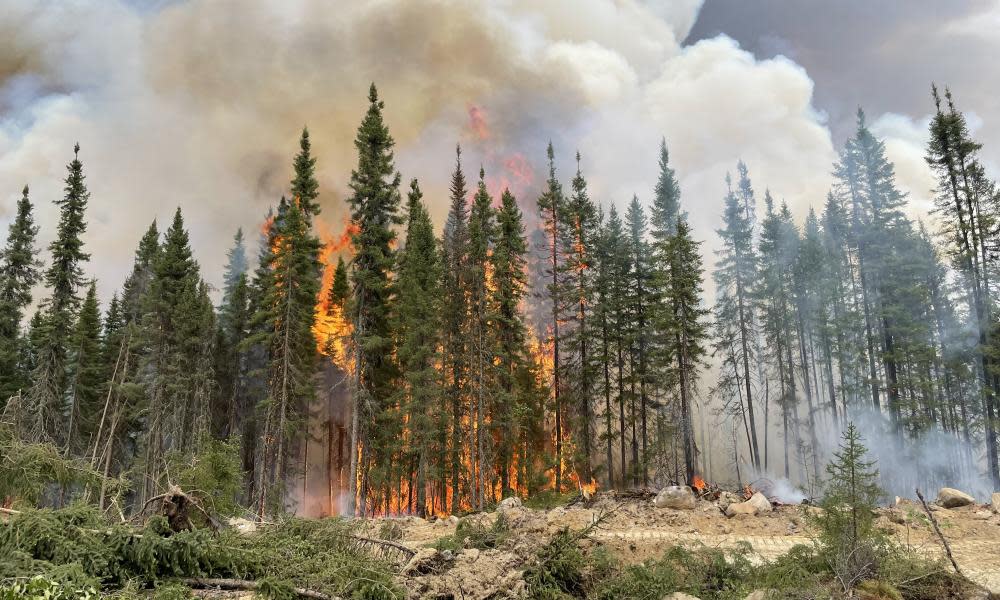Climate crisis made spate of Canada wildfires twice as likely, scientists find

The conditions that caused Canada’s extreme spate of wildfires this year, which resulted in parts of the US and Canada to be blanketed in toxic smoke, were made at least twice as likely due to the human-caused climate crisis, scientists have found.
The 2023 Canadian wildfire season has been the largest, and most devastating, on record, with nearly 14m hectares (34m acres) burned, an area larger than Greece. The extent of these fires, more than double the size of the previous record, caused more than a dozen fatalities and thousands of evacuations, and sent a plume of smoke that unfurled as far as Norway and, for a time in June, turned the sky above New York City orange.
Related: The Hawaii fires are a dire omen of the climate crisis’s cost to Pacific peoples | Kiana Davenport
Scientists have now analyzed the conditions that caused the fires that raged in the Canadian province of Quebec between May and July and found that the climate crisis, driven by the burning of fossil fuels, made them at least twice as likely, and the fire-prone weather at least 20% more intense.
The attribution study, conducted by a coalition of scientists in Canada, the UK and the Netherlands, found that while the fire-prone weather conditions were unprecedented, they are no longer unexpected and will become more commonplace as the worlds continues to heat up.
“The word ‘unprecedented’ doesn’t do justice to the severity of the wildfires in Canada this year,” said Yan Boulanger, research scientist at Natural Resources Canada and part of the World Weather Attribution study team.
“From a scientific perspective, the doubling of the previous burned area record is shocking. Climate change is greatly increasing the flammability of the fuel available for wildfires – this means that a single spark, regardless of its source, can rapidly turn into a blazing inferno.”
The new study looked at the fire weather index, a metric that gauges the risk of wildfire through a combination of temperature, windspeed, humidity and rainfall, and found that its peak in Quebec from May to July, when there was a huge number of fires, had its chances of occurring doubled because of the climate crisis. The fires in this peak were also 20% more intense because of the climate crisis.
While climate change itself doesn’t typically ignite huge forest fires, it helps set the stage for them by drying out vegetation that becomes easy fuel for flames. The early stages of summer were ideal conditions for this, with Canada’s national temperature record for May and June smashed by 0.8C (1.4F), which, along with low humidity and the shrinkage of snow cover, aided the rapid spread of fires across Canada.
Philippe Gachon, a researcher at the Université du Québec à Montréal, said that snow cover has traditionally limited the extent of wildfires in Canada, but that this is changing.
“This year, high temperatures led to the rapid thawing and disappearance of snow during May, particularly in eastern Quebec, resulting in unusually early wildfires,” he said. “The ongoing loss of snow in a warming climate means that wildfires will burn for many more days each year in Canada.”
The fires had far-reaching consequences due to the pall of smoke that wafted over Canadian cities including Toronto and Ottawa before heading south to engulf parts of the US. New York temporarily had the worst air quality in the world due to the smoke, prompting people to stay indoors and don masks not worn since the height of the Covid pandemic.
Scientists were previously reluctant to link any individual event, or events, to the climate crisis but the emerging field of attribution has enabled researchers to make stronger and swifter conclusions about the influence of global heating upon extreme weather. Recent studies have shown that the heatwaves that have stricken the US, Europe and China this year were almost impossible without the conditions caused by the climate crisis.
“Increasing temperatures are creating tinderbox-like conditions in forests in Canada and around the world,” said Friederike Otto, a climate scientist at Imperial College London.
“Until we stop burning fossil fuels, the number of wildfires will continue to increase, burning larger areas for longer periods of time.”

